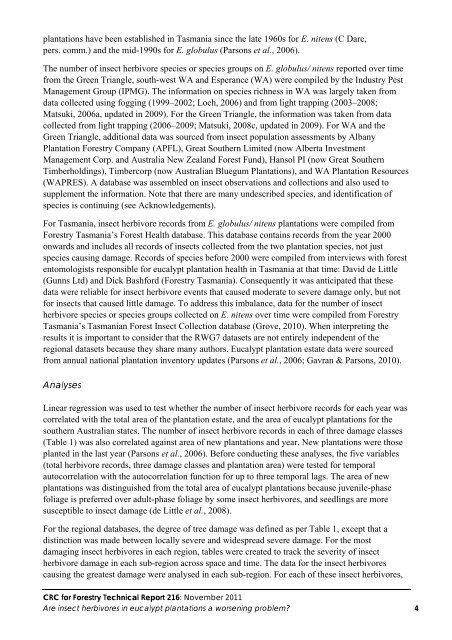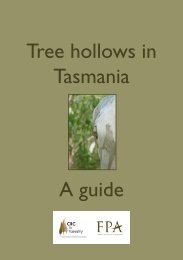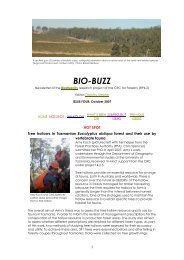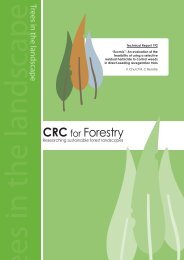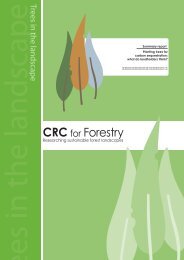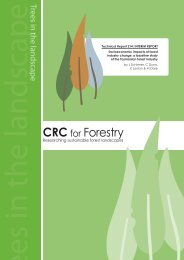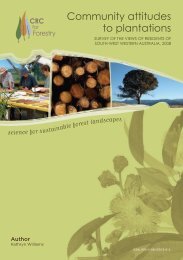CRC Forestry - CRC for Forestry
CRC Forestry - CRC for Forestry
CRC Forestry - CRC for Forestry
You also want an ePaper? Increase the reach of your titles
YUMPU automatically turns print PDFs into web optimized ePapers that Google loves.
plantations have been established in Tasmania since the late 1960s <strong>for</strong> E. nitens (C Dare,<br />
pers. comm.) and the mid-1990s <strong>for</strong> E. globulus (Parsons et al., 2006).<br />
The number of insect herbivore species or species groups on E. globulus/ nitens reported over time<br />
from the Green Triangle, south-west WA and Esperance (WA) were compiled by the Industry Pest<br />
Management Group (IPMG). The in<strong>for</strong>mation on species richness in WA was largely taken from<br />
data collected using fogging (1999–2002; Loch, 2006) and from light trapping (2003–2008;<br />
Matsuki, 2006a, updated in 2009). For the Green Triangle, the in<strong>for</strong>mation was taken from data<br />
collected from light trapping (2006–2009; Matsuki, 2008c, updated in 2009). For WA and the<br />
Green Triangle, additional data was sourced from insect population assessments by Albany<br />
Plantation <strong>Forestry</strong> Company (APFL), Great Southern Limited (now Alberta Investment<br />
Management Corp. and Australia New Zealand Forest Fund), Hansol PI (now Great Southern<br />
Timberholdings), Timbercorp (now Australian Bluegum Plantations), and WA Plantation Resources<br />
(WAPRES). A database was assembled on insect observations and collections and also used to<br />
supplement the in<strong>for</strong>mation. Note that there are many undescribed species, and identification of<br />
species is continuing (see Acknowledgements).<br />
For Tasmania, insect herbivore records from E. globulus/ nitens plantations were compiled from<br />
<strong>Forestry</strong> Tasmania’s Forest Health database. This database contains records from the year 2000<br />
onwards and includes all records of insects collected from the two plantation species, not just<br />
species causing damage. Records of species be<strong>for</strong>e 2000 were compiled from interviews with <strong>for</strong>est<br />
entomologists responsible <strong>for</strong> eucalypt plantation health in Tasmania at that time: David de Little<br />
(Gunns Ltd) and Dick Bash<strong>for</strong>d (<strong>Forestry</strong> Tasmania). Consequently it was anticipated that these<br />
data were reliable <strong>for</strong> insect herbivore events that caused moderate to severe damage only, but not<br />
<strong>for</strong> insects that caused little damage. To address this imbalance, data <strong>for</strong> the number of insect<br />
herbivore species or species groups collected on E. nitens over time were compiled from <strong>Forestry</strong><br />
Tasmania’s Tasmanian Forest Insect Collection database (Grove, 2010). When interpreting the<br />
results it is important to consider that the RWG7 datasets are not entirely independent of the<br />
regional datasets because they share many authors. Eucalypt plantation estate data were sourced<br />
from annual national plantation inventory updates (Parsons et al., 2006; Gavran & Parsons, 2010).<br />
Analyses<br />
Linear regression was used to test whether the number of insect herbivore records <strong>for</strong> each year was<br />
correlated with the total area of the plantation estate, and the area of eucalypt plantations <strong>for</strong> the<br />
southern Australian states. The number of insect herbivore records in each of three damage classes<br />
(Table 1) was also correlated against area of new plantations and year. New plantations were those<br />
planted in the last year (Parsons et al., 2006). Be<strong>for</strong>e conducting these analyses, the five variables<br />
(total herbivore records, three damage classes and plantation area) were tested <strong>for</strong> temporal<br />
autocorrelation with the autocorrelation function <strong>for</strong> up to three temporal lags. The area of new<br />
plantations was distinguished from the total area of eucalypt plantations because juvenile-phase<br />
foliage is preferred over adult-phase foliage by some insect herbivores, and seedlings are more<br />
susceptible to insect damage (de Little et al., 2008).<br />
For the regional databases, the degree of tree damage was defined as per Table 1, except that a<br />
distinction was made between locally severe and widespread severe damage. For the most<br />
damaging insect herbivores in each region, tables were created to track the severity of insect<br />
herbivore damage in each sub-region across space and time. The data <strong>for</strong> the insect herbivores<br />
causing the greatest damage were analysed in each sub-region. For each of these insect herbivores,<br />
<strong>CRC</strong> <strong>for</strong> <strong>Forestry</strong> Technical Report 216: November 2011<br />
Are insect herbivores in eucalypt plantations a worsening problem? 4


